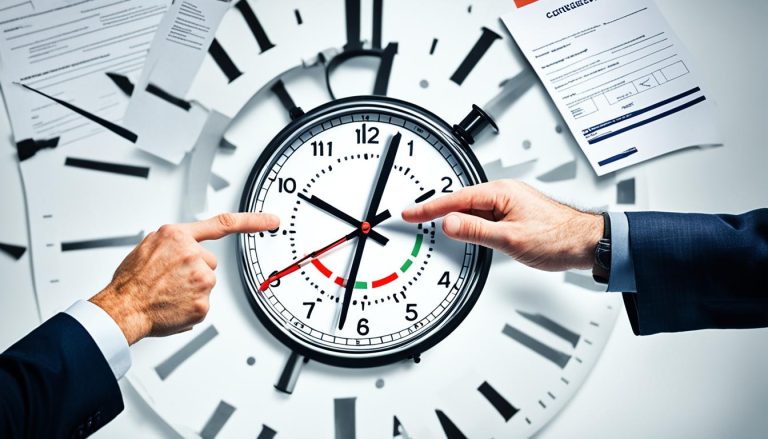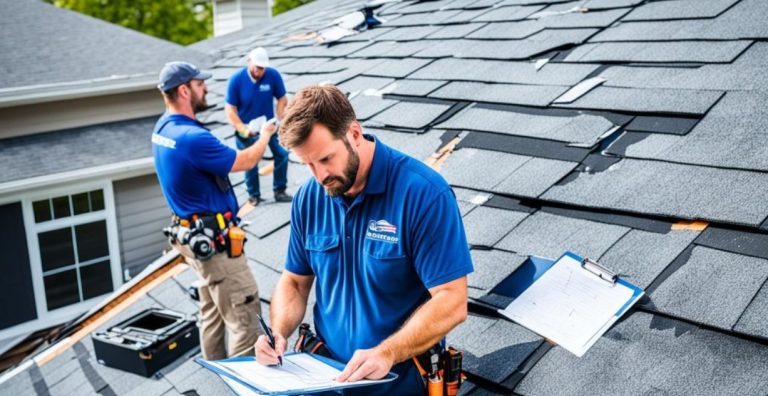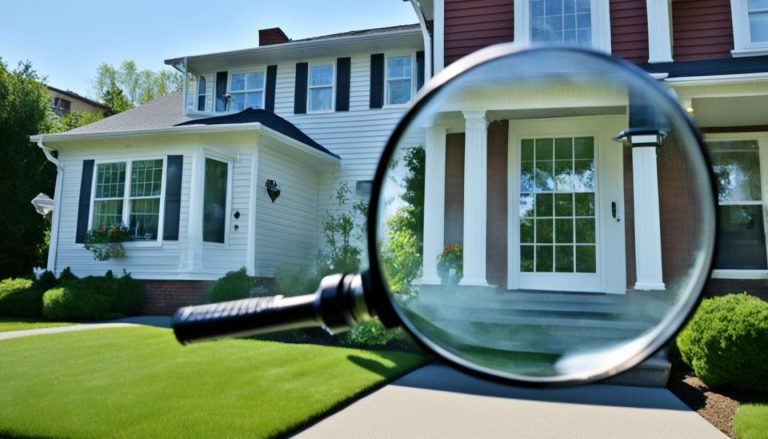Moving into a new house is a significant milestone, but it also requires thorough planning and preparation. One of the most effective ways to ensure a smooth transition is by using a detailed checklist.
This guide provides a room-by-room breakdown of the essential items needed for a new home. From kitchen tools to safety equipment, each section is designed to help homeowners prioritise their purchases and settle in with confidence. Start your move right with this practical and comprehensive checklist.
What Are the Essential Items to Buy Before Moving Into a New House?
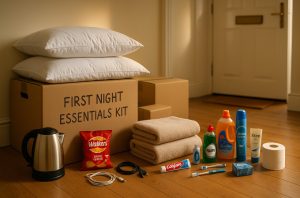
Before the boxes arrive and the removal van pulls away, every new homeowner should ensure that certain essentials are already in place. These are the foundational items that allow you to function in your home from the very first moment. Without them, even the most well-planned move can become unnecessarily stressful.
One of the most helpful ways to stay organised is by preparing a “first night essentials kit.” This kit should include the basic necessities you’ll need immediately, allowing you to cook a meal, use the bathroom, and get a good night’s sleep without having to open multiple boxes.
Here are the most important categories to cover before move-in day:
Basic Comfort & Daily Use
- A set of bed linen, including pillows and a duvet, to make at least one bed
- A clean set of clothes and nightwear for the first night and next day
- Slippers or comfortable shoes for walking around the house
Personal Hygiene Essentials
- Toothbrush, toothpaste, face cloth, and hand soap
- Toilet paper, bath towels, and hand towels
- Any prescription medications or daily health items
Essential Tools & Convenience Items
- A utility knife or scissors for opening boxes
- Extension leads and phone chargers
- Torch or battery-operated lights if the electricity is delayed
- Basic cutlery, plates, and cups for a quick meal
Cleaning & Maintenance
- Multi-surface cleaner and paper towels
- Bin liners for unpacking debris and take-away rubbish
- Dustpan and brush or a hand-held vacuum
Food and Drink for the First 24 Hours
- Bottled water and tea or coffee
- Quick meals like sandwiches, canned soup, or ready-to-eat pasta
- Snacks to keep your energy up throughout the day
These items help ensure that your move isn’t disrupted by missing basics. It’s also a good idea to check whether key services are up and running. For instance, ensure that gas and electricity accounts are active, the water supply is working, and at least one light fixture in each room is functional.
Having this essentials list prepared and packed separately allows you to transition into your new home more smoothly without having to search through dozens of boxes.
What Kitchen Essentials Should Every New Homeowner Have?
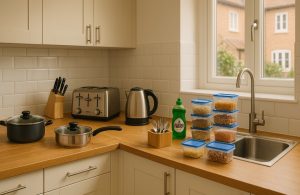
The kitchen is typically one of the first rooms to become fully operational, as it supports your basic daily needs like eating, drinking, and storing food. While setting up the entire kitchen may take time, it’s vital to have the core items ready to go as soon as you move in.
Start by thinking about the kitchen as several functional zones: cooking, storing, eating, and cleaning. Each of these zones has specific tools and equipment that make daily tasks easier and more efficient.
Cooking Zone Essentials
Even if you’re not a keen chef, having the basics allows you to prepare simple meals without relying on takeaways.
- Frying pan, saucepan, and baking tray
- Wooden spoon, spatula, and cooking tongs
- Measuring jug and mixing bowl
- Chopping board and a good set of knives
If you’re moving into a property without fitted appliances, you may need to budget for a cooker or hob, though many rental homes already include these.
Storage & Food Organisation
Storage is key to keeping a tidy kitchen. Whether you’re storing fresh food in the fridge or leftovers in containers, it pays to have a few practical items from the start.
- Food containers with lids for leftovers
- Cling film, aluminium foil, and sandwich bags
- Dry food storage jars for cereals, pasta, and rice
- Bread bin and spice rack (optional, but helpful)
Clear labelling can also help keep track of food expiration dates, especially when settling into a new routine.
Small Appliances & Electricals
These time-saving tools can be used daily and should be part of any starter kitchen kit:
- Kettle and toaster
- Microwave for quick meals or reheating
- Fridge and freezer (ensure it’s cleaned and switched on before move-in)
- Optional: blender, air fryer, or coffee machine based on your lifestyle
Make sure you have enough plug sockets or extension cords to safely use multiple appliances.
Cutlery & Crockery
You’ll need enough items to cover at least a few meals without having to wash up after every bite.
- Knives, forks, spoons, teaspoons
- Plates, bowls, and mugs
- A few glasses for water or wine
- Serving utensils like salad tongs or a ladle
If you’re moving in with family or flatmates, consider a larger starter set to accommodate everyone.
Cleaning & Waste Management
A clean kitchen helps maintain hygiene and improves your overall experience in the new home.
- Dishwashing liquid, sponge, and scrubber
- Tea towels and drying rack
- Kitchen bin with a lid
- Bin bags, antibacterial spray, and surface wipes
If your home has a dishwasher, check whether it requires salt or rinse aid before use.
Which Bedroom Necessities Are Most Important For A Comfortable Move-In?
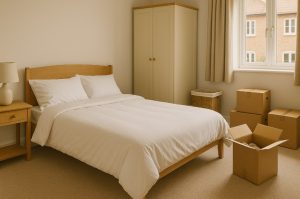
The bedroom is your personal retreat — a place to unwind after the physical and emotional strain of moving. For that reason, it’s one of the most important rooms to set up early. Creating a comfortable and functional bedroom as soon as possible will help you feel settled, even if the rest of the house is still in boxes.
At the very least, your bedroom should be sleep-ready on your first night. Beyond that, focus on functionality, personal comfort, and storage.
Essential Furniture And Sleep Setup
Start with the core items needed for a restful night:
- Bed frame and mattress (ideally delivered or assembled before move-in day)
- Pillows, duvet, and at least one full set of bed linen
- Bedside table for placing essentials like a phone, lamp, or glass of water
- A lamp or light source with a warm, calming glow
If you’re moving into an unfurnished home, consider investing in a mattress-in-a-box or arranging early delivery of large furniture items.
Storage Solutions
Organised storage will help prevent your bedroom from becoming cluttered, especially during unpacking. For wardrobes and drawers:
- A free-standing wardrobe or clothes rail if built-in wardrobes are not available
- Chest of drawers for foldable clothes, documents, or accessories
- Hangers, shoe racks, and drawer dividers to keep items tidy
- Storage boxes or vacuum-seal bags for seasonal items and linens
Under-bed storage is particularly useful in small bedrooms or studio flats, where space is at a premium.
Soft Furnishings And Comfort Items
To make the space feel more homely:
- Curtains or blinds for privacy and light control
- Cushions and throws for added comfort
- A mirror (full-length or wall-mounted) for daily use
- A laundry basket or hamper to keep clothes organised
While decorative elements like artwork, rugs, and photos can wait, soft furnishings can immediately make a bedroom feel welcoming.
Lighting And Atmosphere
Good lighting is essential in a bedroom. Aside from the main ceiling light, bedside lamps or wall-mounted reading lights offer soft illumination and help establish a relaxing environment. Consider light bulbs with adjustable brightness or warm tones.
Some people also prefer to have a small fan or air purifier for better airflow and comfort, depending on the season and location of the bedroom.
Taking the time to properly set up your bedroom creates a peaceful space to recharge during the busy moving period and makes your new house feel like home sooner.
What Should Be Included In A Bathroom Setup Checklist?
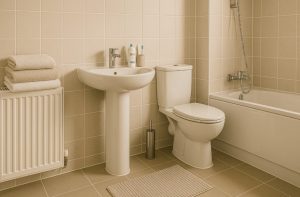
The bathroom is one of the most frequently used rooms in any household. Unlike other parts of the home, it must be functional from the moment you move in. Whether it’s for a quick wash, a relaxing shower, or storing daily essentials, having a fully equipped bathroom ensures comfort and convenience.
A well-planned bathroom setup covers hygiene, cleaning, storage, and organisation. Even if you plan to upgrade the bathroom fittings in the future, it’s vital to stock it with the right basics immediately.
Personal Hygiene Essentials
These are non-negotiables and should be included in your first-night kit:
- Soap, shampoo, conditioner, and shower gel
- Toothbrush, toothpaste, and floss
- Towels (bath towel, hand towel, face cloth)
- Toilet paper and sanitary products
- Razor and shaving cream if applicable
Consider having these items packed in a clearly marked box or bag so they’re easy to access upon arrival.
How Do You Furnish And Decorate Your Living Room After Moving?
The living room serves as a social space for relaxing and entertaining guests. Furnishing it doesn’t have to be immediate, but a few basics can make it comfortable enough to use soon after moving in.
Primary furniture includes:
- A sofa or armchairs
- Coffee table or side tables
- Television and TV unit
- Floor or table lamps
Add cushions and a rug for comfort and warmth. Wall art, picture frames, and plants are great for adding a personal touch. If the space feels too empty at first, use items you already own as temporary décor.
What Tools And Safety Items Should You Have In Your New Home?
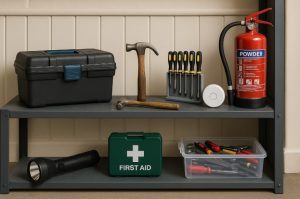
Every home benefits from a basic tool kit and essential safety gear. Whether you’re assembling flat-pack furniture or hanging curtains, the right tools save time and effort.
Tool Kit Recommendations:
- Screwdrivers (flathead and Phillips)
- Hammer, pliers, and adjustable spanner
- Tape measure and utility knife
- Selection of nails and screws
In terms of safety, install and test smoke alarms and carbon monoxide detectors. Place a first aid kit in an easily accessible location and keep a small fire extinguisher or fire blanket in the kitchen.
What Cleaning Supplies Should Be Bought For A New House?
Cleaning should be done before unpacking to make sure everything is fresh and ready. A well-stocked cleaning kit allows you to maintain a clean home as you settle in.
Useful Cleaning Products:
- Multipurpose cleaner and disinfectant
- Limescale remover and glass cleaner
- Cloths, sponges, and gloves
- Mop and bucket or a vacuum cleaner
The following table provides an overview of cleaning categories and examples:
| Cleaning Area | Recommended Products |
| Kitchen Surfaces | Antibacterial spray, dish soap |
| Bathroom | Toilet cleaner, limescale remover |
| Floors | Mop, vacuum, broom |
| Windows & Mirrors | Streak-free glass spray, microfibre cloths |
Keeping these supplies organised in one location will make daily upkeep easier.
What Should Be In A New Home Utility And Service Setup Checklist?
Getting your utilities and services in place should be a priority. Delays in setting up electricity, broadband, or council tax accounts can result in service disruptions or extra charges.
Key utilities to organise:
- Electricity and gas accounts
- Water provider details
- Broadband and landline service
- TV licence if applicable
- Council tax registration with your local authority
- Home and contents insurance policy
It’s also important to take accurate meter readings on the day you move in and submit them to your suppliers to avoid being billed incorrectly.
How Can You Stay Organised With Storage And Decluttering After A Move?
Post-move clutter can be overwhelming if not managed early. Good storage solutions help maintain order while you’re settling in. Start by unpacking only the essentials and avoid putting everything away at once.
Helpful Storage Tips:
- Use under-bed boxes and modular shelving
- Fit hooks on the back of doors or inside cupboards
- Label boxes that remain packed for future sorting
- Repurpose suitcases or baskets for interim storage
Decluttering is best done as you unpack. Dispose of duplicate or unused items to avoid accumulating mess in your new home.
What Are The Best Unpacking And Settling-In Tips For New Homeowners?
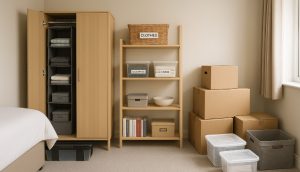
Unpacking gradually is more effective than trying to do everything in one day. Prioritise the most functional rooms such as the kitchen, bedroom, and bathroom.
A practical unpacking plan includes:
- Focusing on one room at a time
- Starting with daily-use items
- Creating a list of remaining tasks to track progress
Adding personal items like framed photos or a familiar blanket can help create a comforting atmosphere quickly. Settling in is about making the space feel like your own, not rushing to fill every corner.
Conclusion
A room-by-room checklist helps break down a complex process into manageable tasks. It reduces the chances of forgetting key items, saves time by guiding your shopping and packing, and gives a clear picture of what needs to be budgeted. Most importantly, it provides peace of mind — something everyone needs during a home move.
FAQs about Things to Buy for a New House
What should I prioritise buying first for a new house?
Focus on essentials like bedding, basic kitchenware, toiletries, and cleaning supplies. These are items you’ll need immediately upon moving in.
Do I need to buy everything before I move?
Not necessarily. Prioritise urgent items first, and then furnish and decorate over time based on your needs and budget.
How can I budget for all the things I need for a new home?
Create a list room-by-room and estimate costs for each. Use comparison websites and sales to find the best deals on big-ticket items.
Should I take old furniture or buy new?
This depends on the condition and size of your existing furniture. Consider the layout and style of your new home before deciding.
What is a first night box and why is it important?
A first night box contains essential items you’ll need immediately upon arrival — toiletries, basic food, chargers, and a change of clothes. It saves you from digging through boxes when tired.
Are there services that help with new home setups?
Yes, in the UK there are professional moving companies and concierge services that assist with unpacking, utilities, and initial setups.
How long does it take to fully settle into a new house?
It can take anywhere from a few weeks to several months. Everyone’s pace is different — focus on essentials first and decorate gradually.



